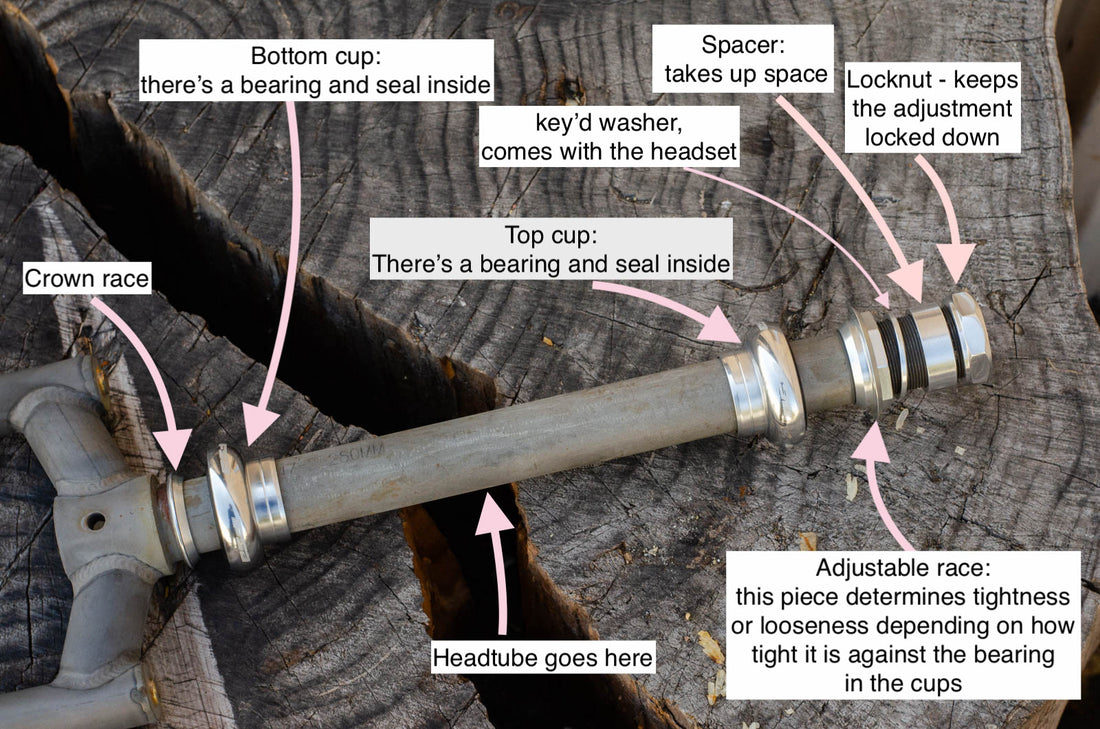With the exception of the Gus, some Roadeo frames and the HubbuHubbuH, all of our bikes take an ISO 1 inch threaded headset. If you've got a cartridge bearing headset, like the FSA Duron that we've included with all of our frames since 2012, once it's adjusted properly, and assuming the locknut is tight, you don't have to mess with them until the bearings wear out, but if something does come loose, it's good to know how to get it back to perfect.
Assuming the cups are already pressed in and everything is greasy and good, you'll only need:
- a headset wrench - these are generally thin so they fit onto adjustable cups that have thin flats. Most headsets take a 32mm wrench.
- A wrench for the locknut. A big adjustable crescent works but my favorite is this Stein, which makes it almost impossible for it to slip.

It's easy to tell when a headset is too loose because the steerer tube knocks when you use the front brake. It's a little harder to tell when your headset is too tight (unless it's really tight), but if you pick the bike up, lean it over at a 30 degree angle and your wheel doesn't flop over, it's a good bet it's too tight. You want the bearings adjusted as loosely as possible without play.
The first step is to loosen the locknut with the thicker wrench. If your headset has come loose, the locknut might be loose already. If you can't loosen it by hand and there's a wheel in the bike, sandwich it between your knees the fork doesn't spin as you loosen. Once the locknut is loose, you can adjust the adjustable race with the thin wrench. Back it off the bearing if your headset is too tight, and turn it in if your headset is too loose. Go back and forth between adjusting the race and hitting the front brake and rocking the bike back and forth to find the adjustment that's smooth and EZ turning but without any play.
Once you're satisfied with the adjustment, then comes the tricky part. The best way to tighten a threaded headset so it won't come loose is to scissor lock the locknut into the adjustable cup. It looks like this:

The tricky thing is that by turning the adjustable race to the left to scissor lock it into the locknut, you'll loosen the adjustment, so you have to preemptively tighten the adjustable race more than you want in the final adjustment.
How much you preemptively tighten depends on how close the locknut is to being tight. If the locknut is pretty loose, you'll end up loosening the adjustable race quite a bit as you scissor lock them together. If the locknut is close to being tight, you'll only need to overtighten the adjustable race a little bit.
Generally I tighten the locknut using the wrench but without muscling it, and overtighten the adjustable race about a 1/4 of a turn. Then I scissor lock them, and check for too-looseness with the front brake, and too-tightness by tipping the bike to the side. Make sure to have all the flats of the thin wrench engaged on the adjustable race; it's super easy for that tool to slip and round out the corners of the flats. I usually press the tool down while I turn it to the left to prevent slipping.
These instructions are written for people who are working on a complete bike, but if you're adjusting it on a frameset, it's basically the same, although you won't be able to use the front brake as a tool to gauge adjustment. To check for looseness on a frame, hold the headtube with your left hand and push the fork back and forth with your right to see if there's any play. Checking for tightness is a little more difficult, but an FSA Duron is properly adjusted when you can spin the fork 360 degrees. Loose ball bearing headsets like the Tange Passage will spin more freely. It's best to re-check the adjustment of the headset once the bike is built. Also, this esoteric tool is super handy if you need to loosen the locknut and there's no wheel.
I've adjusted hundreds of FSA Durons over the years, so I'm fairly good at it, but I still sometimes have to loosen the locknut and try again. Once you understand the anatomy of the headset, the nervousness is gone and you can work until it's right. If you haven't done it before, get a cheap headset wrench and try it out; you won't mess anything up. Well, maybe you'll chew up the corners of your adjustable race, but that's OK. Fix headsets for your friends too. Tons of people ride with loose headsets and don't even know it.

